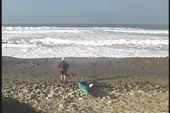 As a review, it is a good idea to scout out the surf zone
before you launch. You are looking at wave timing, size, breaking zone, whitewater
zone, potential staging area, potential obstacles and your launching spot
in the wave run-up zone.
As a review, it is a good idea to scout out the surf zone
before you launch. You are looking at wave timing, size, breaking zone, whitewater
zone, potential staging area, potential obstacles and your launching spot
in the wave run-up zone.Shore Spin For The Surf Zone
By Wayne Horodowich
Even with your best planning there are times where you will find yourself being turned parallel to the incoming surf while you are still on the beach. Your goal for a surf launch is to have your kayak perpendicular to the incoming surge. This could be a good time to do a quick review of USK's article "Launching A Kayak Through surf" (Skill of the month September 2003) to appreciate the necessity of the shore spin.
If you are parallel to the water you will not be able to launch unless a large surge comes up to you and you are unlucky enough to be floated out with the surge water. I say unlucky because the odds are you are heading sideways to an incoming wave. Again, your goal is have your kayak perpendicular to the incoming surge for the least resistance from the water force coming toward you.
If you are sideways you only have a few options to correct your position. The most common is to get out and reposition your kayak and start the launching process again. You may be lucky enough to have a partner who can turn you and your kayak back into position.
I prefer the shore spin. It is quicker and the spin allows me to stay in my kayak. I use the spin for minor or major adjustments. Let's see how to do it.
 As a review, it is a good idea to scout out the surf zone
before you launch. You are looking at wave timing, size, breaking zone, whitewater
zone, potential staging area, potential obstacles and your launching spot
in the wave run-up zone.
As a review, it is a good idea to scout out the surf zone
before you launch. You are looking at wave timing, size, breaking zone, whitewater
zone, potential staging area, potential obstacles and your launching spot
in the wave run-up zone.
After you gather the information you need from your environment, you will commit to your launching spot. Remember, this is not a place to start adjusting your foot pegs or equipment. All that was done prior to this point.
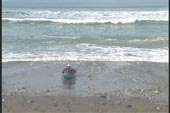 Your goal is to get into your kayak and secure your spray
skirt to the coaming as quickly as possible. When the surge water comes up
to your kayak you can do a "Mermaid's Walk" to meet the water and
propel yourself along with the outgoing surge to do a textbook launch.
Your goal is to get into your kayak and secure your spray
skirt to the coaming as quickly as possible. When the surge water comes up
to your kayak you can do a "Mermaid's Walk" to meet the water and
propel yourself along with the outgoing surge to do a textbook launch.
A "Mermaid's Walk" is using both hands or one hand and your paddle to push yourself down the beach. If you use your paddle you can chew up the tip of your paddle depending on the paddles durability. I have a friend who keeps a small stick under his back deck rigging for this very purpose. He calls it his "launching stick." I have used a pair of rubberized work gloves for rocky beach areas just for launching and I took them off when I got to the staging area. Neoprene gloves can get chewed up quickly depending upon the style you use.
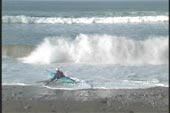 Even when you think you have chosen a good launching position, things don't always go according to plan. Due to
the dynamic forces around you and the varied contours of most beaches, moving
surge water can end up turning your kayak against your will. It is not uncommon
to end up sideways.
Even when you think you have chosen a good launching position, things don't always go according to plan. Due to
the dynamic forces around you and the varied contours of most beaches, moving
surge water can end up turning your kayak against your will. It is not uncommon
to end up sideways.
As a side note, the longer you take getting in your kayak and attaching your spray skirt the greater the chance you will end up sideways. This is why spray skirt attachment drills are important for the surf zone. Again you need to be in your kayak with spray skirt attached as quickly as possible.
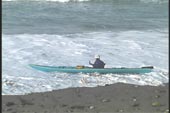 When you are parallel to the surge water you can be moved
around quite a bit by each incoming wave. This is where serious damage can
occur to you and your equipment. You really want to avoid being sideways. I have seen paddlers get rolled multiple times by big surge water. Getting rolled on the beach is not a pleasant experience. Scrapes and cuts are assured when this happens. Even though I haven't heard of it happening yet, a broken neck is not out of the question if you are being rolled around on shore.
When you are parallel to the surge water you can be moved
around quite a bit by each incoming wave. This is where serious damage can
occur to you and your equipment. You really want to avoid being sideways. I have seen paddlers get rolled multiple times by big surge water. Getting rolled on the beach is not a pleasant experience. Scrapes and cuts are assured when this happens. Even though I haven't heard of it happening yet, a broken neck is not out of the question if you are being rolled around on shore.
I haven't mentioned it yet, but I am sure it is obvious from the pictures that helmets are highly recommended when launching and landing in the surf.
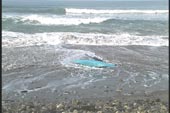 When you are ready and you have stopped moving around, you
will need to fully lay your kayak over on it's edge so you can spin your kayak.
With your kayak on edge and you laying on the shore, you have the body leverage
to spin your kayak. When your kayak is on edge there is the least resistance
from the shore, because only a small section of your kayak is in contact with
the shore.
When you are ready and you have stopped moving around, you
will need to fully lay your kayak over on it's edge so you can spin your kayak.
With your kayak on edge and you laying on the shore, you have the body leverage
to spin your kayak. When your kayak is on edge there is the least resistance
from the shore, because only a small section of your kayak is in contact with
the shore.
In this example Rod laid towards the water, planted his upper body in the sand and pulled the kayak around by pulling his knees up into the top deck. He is executing a stomach crunch to get the kayak around. In most cases it is usually easier to fall toward the water because of the slope of the beach. It also seems easier for most people to do a stomach crunch to turn the kayak rather than pushing it around (which is shown later in the article).
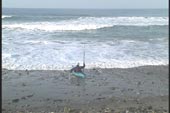 Even though I think this is a great method it does take some
work and you do get dirty in the process. The key to the skill is getting
your kayak completely on it's edge.
Even though I think this is a great method it does take some
work and you do get dirty in the process. The key to the skill is getting
your kayak completely on it's edge.
Remember, your goal is to get your kayak perpendicular to the incoming surge water preferably with your bow pointing toward the water. You can also launch backwards, but if you are going to spin try launching forward. The only reason I would launch backwards is if my kayak ended up spinning around so much I was almost pointing backwards already. This way I have less of a spin. When back in position proceed with your launch.
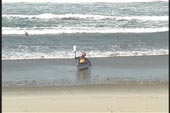 In this next sequence Chuck decides he needs to do a minor
adjustment to get his kayak in the correct launching position. He uses his
paddle to push off of the sand while throwing his body forcefully to the side
to get the kayak on edge.
In this next sequence Chuck decides he needs to do a minor
adjustment to get his kayak in the correct launching position. He uses his
paddle to push off of the sand while throwing his body forcefully to the side
to get the kayak on edge.
This can be the hardest part of the skill for those smaller paddlers. If you do not have the upper body weight to get that kayak over on it's side you may have to rock the kayak to help get it over.
 I have found throwing your full body weight to the side with
both your arms (with your paddle in hand) can help you get over. Your particular kayak design
can help or hinder this skill. The more flat your hull design the more you
will have to work to get the kayak edged. There are times when the wet sand
causes a little suction with the hull making it more difficult to edge the
kayak. Rocking can help break that suction.
I have found throwing your full body weight to the side with
both your arms (with your paddle in hand) can help you get over. Your particular kayak design
can help or hinder this skill. The more flat your hull design the more you
will have to work to get the kayak edged. There are times when the wet sand
causes a little suction with the hull making it more difficult to edge the
kayak. Rocking can help break that suction.
In this sequence Chuck decided to fall away from the water which means he will most likely push the kayak around. The bow is moving away from his torso as compared to the earlier example where Rod pulled the bow towards his torso. This is an example of trying out both methods to see which one works best for you and your kayak.
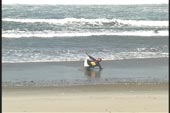 Here is a good example of fully edging your kayak. You can
see there is only contact with the side edge and the shore. It is interesting how much difference your kayak design can make when trying to perform this skill. I have had some spin easily and others that took a lot of work. The sand consistency is also a big factor.
Here is a good example of fully edging your kayak. You can
see there is only contact with the side edge and the shore. It is interesting how much difference your kayak design can make when trying to perform this skill. I have had some spin easily and others that took a lot of work. The sand consistency is also a big factor.
Remember you may only have that 8-12 seconds (wave interval) between the next surge to get this preposition completed depending on the surge.
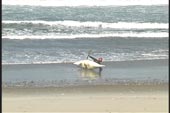 Something that needs to be taken into consideration is the
potential abrasion to the side of your kayak. Those with composite kayaks
are usually more concerned about scratching their boats. Even though abrasions happen, you will not be using this skill very often if you angle your kayak correctly when you put it down to launch.
Something that needs to be taken into consideration is the
potential abrasion to the side of your kayak. Those with composite kayaks
are usually more concerned about scratching their boats. Even though abrasions happen, you will not be using this skill very often if you angle your kayak correctly when you put it down to launch.
I usually joke during my lectures that you should practice these skills with your friends kayak or rent a plastic one to do your learning. You have to weigh the pros and cons of when, where, and if you use this skill.
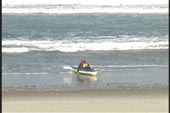 After Chuck gets to his launching angle he heads toward the
water. By using the spin he did not have to get out of his kayak.
After Chuck gets to his launching angle he heads toward the
water. By using the spin he did not have to get out of his kayak.
For those who like to play in the surf zone you will find this skill quite useful when you get near shore and your kayak begins to bottom out. When I end up surfing in and I want to go back out, I use the spin to correctly position my kayak. I use a lot less energy by using the spin than getting out of my kayak each time I bottom out.
Again, since this is a surf zone skill remember to where your helmet. In addition, pay attention to the surge water. Try to execute the spin before the next surge comes running up the beach. Timing is important. During winter surf the surge water can be very forceful which is not very user friendly to a paddler lying on their side.
One of the reasons I prefer falling toward the water side is not presenting my hull to the incoming surge. I have seen a large winter wave wash up the beach and hit the exposed hull with enough force to roll the kayak over the person lying toward the beach side. In the surf zone it is always good to stick with the basic principle of edging toward the waves.
So the next time you are getting ready to launch and your kayak gets turned due to the surge water, you have another option to consider for correcting your position.
Pictures seen above were taken from the USK Video "ABC'S of the Surf Zone"
© Copyright USK